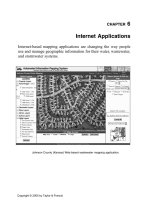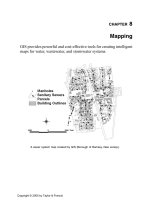Decision support and BI systems chapter 04
Bạn đang xem bản rút gọn của tài liệu. Xem và tải ngay bản đầy đủ của tài liệu tại đây (796.57 KB, 50 trang )
Decision Support and
Business Intelligence
Systems
(9th Ed., Prentice Hall)
Chapter 4:
Modeling and Analysis
Learning Objectives
4-2
Understand the basic concepts of
management support system (MSS) modeling
Describe how MSS models interact with data
and the users
Understand the well-known model classes and
decision making with a few alternatives
Describe how spreadsheets can be used for
MSS modeling and solution
Explain the basic concepts of optimization,
simulation and heuristics; when to use which
Copyright © 2011 Pearson Education, Inc. Publishing as Prentice Hall
Learning Objectives
4-3
Describe how to structure a linear
programming model
Understand how search methods are used to
solve MSS models
Explain the differences among algorithms,
blind search, and heuristics
Describe how to handle multiple goals
Explain what is meant by sensitivity analysis,
what-if analysis, and goal seeking
Describe the key issues of model management
Copyright © 2011 Pearson Education, Inc. Publishing as Prentice Hall
Opening Vignette:
“Model-Based Auctions Serve More
Lunches in Chile”
Background: problem situation
Proposed solution
Results
Answer and discuss the case questions
4-4
Copyright © 2011 Pearson Education, Inc. Publishing as Prentice Hall
Modeling and Analysis Topics
4-5
Modeling for MSS (a critical component)
Static and dynamic models
Treating certainty, uncertainty, and risk
Influence diagrams (in the posted PDF file)
MSS modeling in spreadsheets
Decision analysis of a few alternatives (with
decision tables and decision trees)
Optimization via mathematical programming
Heuristic programming
Simulation
Model base management
Copyright © 2011 Pearson Education, Inc. Publishing as Prentice Hall
MSS Modeling
A key element in most MSS
Leads to reduced cost and increased
revenue
DuPont Simulates Rail Transportation System
and Avoids Costly Capital Expenses
Procter & Gamble uses several DSS models
collectively to support strategic decisions
4-6
Locating distribution centers, assignment of DCs to
warehouses/customers, forecasting demand,
scheduling production per product type, etc.
Fiat, Pillowtex (…operational efficiency)…
Copyright © 2011 Pearson Education, Inc. Publishing as Prentice Hall
Major Modeling Issues
Problem identification and environmental
analysis (information collection)
Variable identification
Forecasting/predicting
4-7
More information leads to better prediction
Multiple models: A MSS can include several
models, each of which represents a
different part of the decision-making
problem
Influence diagrams, cognitive maps
Categories of models >>>
Model management
Copyright © 2011 Pearson Education, Inc. Publishing as Prentice Hall
Categories of Models
Category
4-8
Objective
Techniques
Optimization of
problems with few
alternatives
Find the best solution from Decision tables,
a small number of
decision trees
alternatives
Optimization via
algorithm
Find the best solution from
a large number of
alternatives using a stepby-step process
Linear and other
mathematical
programming
models
Optimization via
an analytic formula
Find the best solution in
one step using a formula
Some inventory
models
Simulation
Find a good enough
solution by experimenting
with a dynamic model of
the system
Several types of
simulation
Heuristics
Find a good enough
solution using “commonsense” rules
Heuristic
programming and
expert systems
Predictive
and
Predict future
Forecasting, Markov
Copyright © 2011 Pearson Education, Inc. Publishing as Prentice Hall
other models
occurrences, what-if
chains, financial, …
Static and Dynamic Models
Static Analysis
Dynamic Analysis
4-9
Single snapshot of the situation
Single interval
Steady state
Dynamic models
Evaluate scenarios that change over time
Time dependent
Represents trends and patterns over time
More realistic: Extends static models
Copyright © 2011 Pearson Education, Inc. Publishing as Prentice Hall
Decision Making:
Treating Certainty, Uncertainty and
Risk
Certainty Models
Uncertainty
Several outcomes for each decision
Probability of each outcome is unknown
Knowledge would lead to less uncertainty
Risk analysis (probabilistic decision making)
4-10
Assume complete knowledge
All potential outcomes are known
May yield optimal solution
Probability of each of several outcomes
occurring
Level of uncertainty => Risk (expected value)
Copyright © 2011 Pearson Education, Inc. Publishing as Prentice Hall
Certainty, Uncertainty and Risk
4-11
Copyright © 2011 Pearson Education, Inc. Publishing as Prentice Hall
Influence Diagrams
(Posted on the Course Website)
Graphical representations of a model
“Model of a model”
A tool for visual communication
Some influence diagram packages create and
solve the mathematical model
Framework for expressing MSS model
relationships
Rectangle = a decision variable
Circle = uncontrollable or intermediate variable
Oval = result (outcome) variable: intermediate or final
Variables are connected with arrows indicates the
direction of influence (relationship)
4-12
Copyright © 2011 Pearson Education, Inc. Publishing as Prentice Hall
Influence Diagrams:
Relationships
CERTAINTY
Amount in
CDs
Interest
Collected
UNCERTAINTY
Price
Sales
The shape of
the arrow
indicates the
type of
relationship
RANDOM (risk) variable: Place a tilde (~) above the variable’s name
~
Demand
Sales
4-13
Copyright © 2011 Pearson Education, Inc. Publishing as Prentice Hall
Influence Diagrams: Example
An influence diagram for the profit model
Unit Price
~
Amount used in
Advertisement
Income
Units Sold
Profit
Profit = Income – Expense
Unit Cost
Income = UnitsSold * UnitPrice
UnitsSold = 0.5 * Advertisement Expense
Expenses = UnitsCost * UnitSold + FixedCost
Expenses
Fixed Cost
4-14
Copyright © 2011 Pearson Education, Inc. Publishing as Prentice Hall
Influence Diagrams: Software
Analytica, Lumina Decision Systems
DecisionPro, Vanguard Software Co.
Integrates influence diagrams and Excel, also supports
Monte Carlo simulations
PrecisionTree, Palisade Co.
4-15
Includes influence diagrams, decision trees and
simulation
Definitive Scenario, Definitive Software
Supports hierarchical (tree structured) diagrams
DATA Decision Analysis, TreeAge Software
Supports hierarchical (multi-level) diagrams
Creates influence diagrams and decision trees directly
in an Excel spreadsheet
Copyright © 2011 Pearson Education, Inc. Publishing as Prentice Hall
Analytica Influence Diagram of a
Marketing
Problem: The Marketing Model
4-16
Copyright © 2011 Pearson Education, Inc. Publishing as Prentice Hall
Analytica: The Price Submodel
4-17
Copyright © 2011 Pearson Education, Inc. Publishing as Prentice Hall
Analytica: The Sales Submodel
4-18
Copyright © 2011 Pearson Education, Inc. Publishing as Prentice Hall
MSS Modeling with Spreadsheets
Spreadsheet: most popular end-user modeling
tool
Flexible and easy to use
Powerful functions
4-19
Add-in functions and solvers
Programmability (via macros)
What-if analysis
Goal seeking
Simple database management
Seamless integration of model and data
Incorporates both static and dynamic models
Examples: Microsoft Excel, Lotus 1-2-3
Copyright © 2011 Pearson Education, Inc. Publishing as Prentice Hall
Excel spreadsheet - static model example:
Simple loan calculation of monthly
payments
F = P(1 + i ) n
i (1 + i ) n
A = P
n
(
1
+
i
)
−
1
4-20
Copyright © 2011 Pearson Education, Inc. Publishing as Prentice Hall
Excel spreadsheet Dynamic model
example:
Simple loan
calculation of
monthly payments
and effects of
prepayment
4-21
Copyright © 2011 Pearson Education, Inc. Publishing as Prentice Hall
Decision Analysis: A Few
Alternatives
Single Goal Situations
Decision tables
Decision trees
4-22
Multiple criteria decision analysis
Features include decision
variables (alternatives),
uncontrollable variables, result
variables
Graphical representation of
relationships
Multiple criteria approach
Demonstrates complex
relationships
Cumbersome, if many
alternatives exists
Copyright © 2011 Pearson Education, Inc. Publishing as Prentice Hall
Decision Tables
Investment example
One goal: maximize the yield after one year
Yield depends on the status of the economy
(the state of nature)
4-23
Solid growth
Stagnation
Inflation
Copyright © 2011 Pearson Education, Inc. Publishing as Prentice Hall
Investment Example:
Possible Situations
1. If solid growth in the economy, bonds yield
12%; stocks 15%; time deposits 6.5%
2. If stagnation, bonds yield 6%; stocks 3%;
time deposits 6.5%
3. If inflation, bonds yield 3%; stocks lose 2%;
time deposits yield 6.5%
4-24
Copyright © 2011 Pearson Education, Inc. Publishing as Prentice Hall
Investment Example:
Decision Table
4-25
Payoff Decision variables (alternatives)
Uncontrollable variables (states of economy)
Result variables (projected yield)
Tabular representation:
Copyright © 2011 Pearson Education, Inc. Publishing as Prentice Hall









